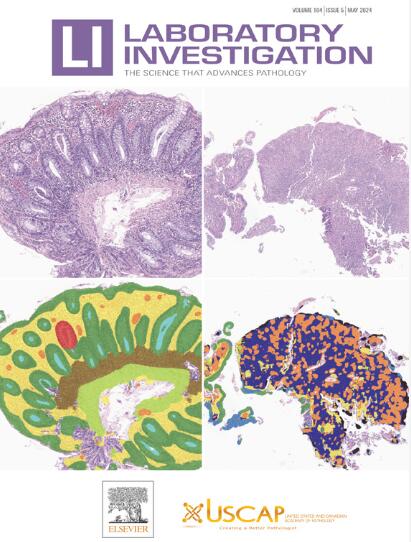apoobec驱动的三阴性乳腺癌淋巴细胞显性组的高突变。
IF 5.1
2区 医学
Q1 MEDICINE, RESEARCH & EXPERIMENTAL
引用次数: 0
摘要
本研究旨在评估三阴性乳腺癌(TNBC)亚型的临床病理和基因组特征。根据雄激素受体免疫组化和til水平,将TNBC分为腔内雄激素受体(LAR)亚型和非LAR亚型淋巴细胞-淋巴细胞优势型(LP)、淋巴细胞中间型(LI)和淋巴细胞耗尽型(LD)的肿瘤浸润淋巴细胞组。评估这些TNBC亚型的临床病理和基因组特征。LP组与具有髓样特征的癌的组织学类型相关,肿瘤突变负担较高,APOBEC活性增加,表明apobecc驱动的高突变。LAR亚型的特点是PIK3CA突变的发生率较高,同源重组缺陷评分较低,并与浸润性小叶癌和大浆分化癌的组织学类型相关。本研究显示了三阴癌亚型的不同临床病理和基因组特征。APOBEC活性相关的高突变是LP组的一个决定性特征。本文章由计算机程序翻译,如有差异,请以英文原文为准。
APOBEC-Driven Hypermutation in the Lymphocyte-Predominant Group of Triple-Negative Breast Cancer
This study aimed to evaluate the clinicopathologic and genomic characteristics of triple-negative breast cancer subclassification. Triple-negative breast cancer was classified into the luminal androgen receptor (LAR) subtype and the tumor-infiltrating lymphocytes (TILs) groups of the non-LAR subtype—lymphocyte predominant (LP), lymphocyte intermediate, and lymphocyte depleted—based on androgen receptor immunohistochemistry and TILs. Clinicopathologic and genomic characteristics were evaluated for these triple-negative breast cancer subclasses. The LP group was associated with a histologic type of carcinoma with medullary features, a higher tumor mutation burden, and increased APOBEC activity, indicative of APOBEC-driven hypermutation. The LAR subtype was characterized by a higher prevalence of PIK3CA mutations, lower homologous recombination deficiency scores, and associations with histologic types of invasive lobular carcinoma, and carcinoma with apocrine differentiation. This study demonstrated the distinct clinicopathologic and genomic characteristics of triple-negative breast cancer subclassifications. APOBEC activity–related hypermutation is a defining characteristic of the LP group.
求助全文
通过发布文献求助,成功后即可免费获取论文全文。
去求助
来源期刊

Laboratory Investigation
医学-病理学
CiteScore
8.30
自引率
0.00%
发文量
125
审稿时长
2 months
期刊介绍:
Laboratory Investigation is an international journal owned by the United States and Canadian Academy of Pathology. Laboratory Investigation offers prompt publication of high-quality original research in all biomedical disciplines relating to the understanding of human disease and the application of new methods to the diagnosis of disease. Both human and experimental studies are welcome.
 求助内容:
求助内容: 应助结果提醒方式:
应助结果提醒方式:


